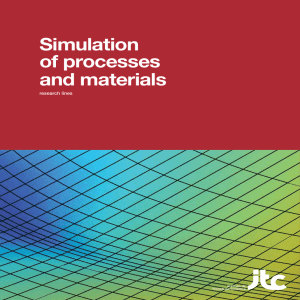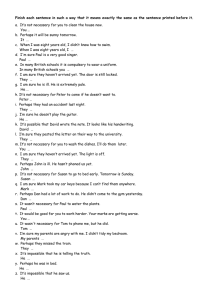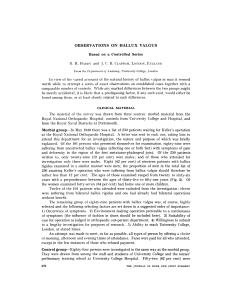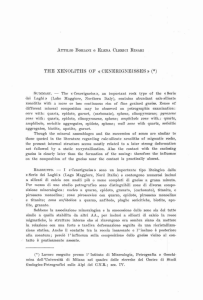1 - Centro de Estudios Económicos
Anuncio
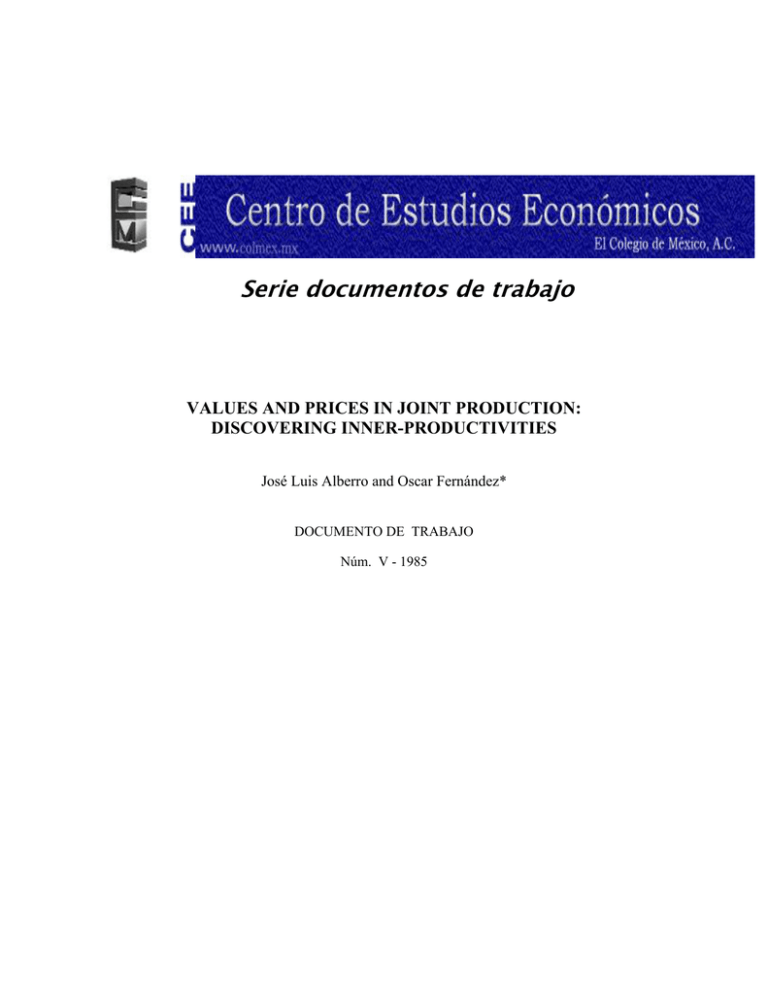
Serie documentos de trabajo
VALUES AND PRICES IN JOINT PRODUCTION:
DISCOVERING INNER-PRODUCTIVITIES
José Luis Alberro and Oscar Fernández*
DOCUMENTO DE TRABAJO
Núm. V - 1985
~.~) fI~ .~o.~. \1 i'~1 T1 7~ I.: ' 1:1 '1 r~ r~ 'f! \.?TI f- fi r~ c~ ~
<'-'--"'-~+.-
•. - ... --------""'---~--.-.-- .•~-.
• ..
--_.-_ •. --_._ ... --
Jose Luis f\LCEf<r<O
\ -·'D rL_7"- ~ F[n~1
. t'1;'!/.r.
OSCd
El Cologio d~ j'-lo:(ico
JClmnr'/ i ggS
~{
On s2bbatic81 from
Po1Jtocnico [\!:=-cjO!'~1.
th(~
Escucla SUDcrior de FisicGl Y t1(ltematicas, Instituto
in HilS p:y?r,
VJG
(J)(tond Uw concept of P(oc!lIctivity dovclorwt1 in tho contm:t
pi'ociucUOil, (U th~) Co,:} ul'juilll ih'ududkn, \J,} ~J:o\JJ in tLJ ~;,:CCiid
s;~\:UCil. tiL;\:. I'CU,di'LLJ
tlh; V0l;(\..;j' c;' ':,:~lt'li:jl i',;'l0A ,ju'i:s t,j LJ S,;/dl' .i)G~)ic;:0
.
rn:::y sUil L)~~.·Jl;lj\)J 'L}'tJ,;S or "ii,Jk!"L:ii,lj·\.;)udi\iji:i..:f, If itL C.lLJi;J,·ikJ J 3J
tl1:J'L inn2l'-UI1:)i\.(i(:ctiviti2s ~;j"\J SGcL.Ji"ii Ul·ld,J:)jl·~,.;)iJ, ViC; VJO(ld:( i{ sockty
li::5 siFI(.iling t,':;vlc,;s tIL;C could i'J\\.J~h2ij' J;,i:;Lil,>J, In til:: tii;IJ s-:ci:i,};l,
""1"
, ' , ". ,.~ ..; .'.
,'.,'). ", ' •. "
'! "..: :
. "J' l~~~('l'('
\ :",1"1 .,. Col
.- '''J'
Vi L'V'i
\).:1
1...l.l\,In,p,,;i 01
\;1 L,.':J UI p."
,1 L'.'.:'--"" .. 1 ~.II
c:.).; I.
\ 'Ji.;\; C·:'-I.'·r.O'
''\~l,''l'':' ':"'~"C \",,"'11) .' ...• ' 1" ....
,·il'" l'····'·, ,', "'\"J (\'.,. )'/'" t!,~",)
t\T""~ r,'"
\.f:V Lli·.:..~L w,j,,~l '-' lli~
.... il.l\.-'! '---·,li,;'·.·:_lj\'\..~:.",-jJJ/ :'I~ll,<{,..,L l ... ·; 01 \..11·";
itl l.'\-.I
i~;J::; vI
co ill.,
r;;i,~)IJ
cf
I
'.
\iUS;',';:),
"11
··L-:,n'
.
I \
~ 1 \..... 'v. I...... \.r.J
I 1,- L
1'"'':''1'''1''''-'·.''1'''''
.J
r:'··./
I J ~ '- • ./
j
c:':;:l:::;l,'ls
V'~I' us~r::;
C(
','-'("1'"
\.i"-' \.., \c.: i)
... , , ; - - , . . .
.,.'j,"""
\ ,;: 1 \......... _)
C\::
,.t· ,',".
·,::~}l..i{),
"'J
,t
V \.... ~_.
~ .... J I \...
>.J
j
'Ll'iJ tCfiil L;I·'~I\'·L;'\)I·JU:_!~tivjtL..:,j:
i"\i~'
i'J l.
(;-;"I'\'~':'
L\,; \.; t.
L,~
··.....~ ~I
1.
-;'1'-",
a I .....J
\....1
ci,.j~.~:hJli2C:
't(,J/
ti,,)
'(OC/;;10100Y iliJ2p-.:n(J1IUy of llbtr·H.Ar~.lo1u-1 8~~)2Ci:S, Zild 1~~l.CO C:jd~l)i: 1)2 ~2,;[1
US;::] li'L:LllitlLL:;s (ii~;;,/:.:t~10d \'/IU, pl··ic~:~~. \'.'0 cC'llLll\~::, cc-lIVc:ry to ~)tc;;JjJ;:,il
(1 ~YFi),;)':Jt ,,'ulU:: c21cuL:tiol-lS ::1'0
Ll(,i'\.')
th~:il
u;;:,:dul
price
cJlcul~jtions.
En este tr2b3jo e)~tendemos el conccpto d2 rroductividad que ha sido dcfinido,
PZt8 el C8S0 d2 proJucclon simplG, 2il C8S0 d2 prollucc16n conjuntJ. En 1:3
S;?~1UndJ Dzrte J~IIlt)SLI';::;ilu:) (juG cl hGer'lo de? r0(ju21'1i~ que 121 vcctOJ' c\,?
prcciuctos n2105 s'}ctori:'.lGs SC:3 S2rfli-rositivo, no climiliJ tres ti()J~) cL}
"1"":,'/,',"·:1
~-:'S il'" L.~J
'-'j',~~""""
... ~.' • c:
'·';(,""';-'1
(ii!")
1-:-,s l"!\l"'''l)(\!'''tl'''l',j'''d';C''
·,7"(1T'1:-::4i, . .JJ ...... ''-' __ .'i~';'11ri{i::
.....
J I <>j
'- .... (,
...............
I·~..............
! !)l
!.l
'-',) .....
• 1
,.
1
•
.
1
.
I
j"
,
son S0C18ilYl2(itG m02s2~,;LOS, nDS Pi'0UUillZ'ffi0S S1 8 :::~OC1N 'le (lOne nnnC?l':J U2
i"!
_1 .... 1\...--" __ ......
rJ'- ....
'\It.ll.....
'"
\...,
J.)
J ... __ ...... )
I
S!J ~",'.;cC"~;:
.. ('i;1
l:.7,-.
f\-:-····L·'':)
..·:'i I'10"
rl"}
II1 C'
U:':;i'Cl"L":-;;'
~~ '"" \.... '-' .......
J.
I
I .......
I t 1""
CJ 'i',r;,""r:r",
\.
~ U
t ,,: ~~ J \", co"{·,,;(;"-:··
I '"-" ~ .
: > 10"
..J c-:-:~oC'
.....
L
prccios ch'J i')to . ~:cci6n \,1. cl2 los vaJc;'cs lrc;;)Jio, v ccnc!uirnos (iU:?, Sl bion cstos
ultimcs d2teC'L;~:il dos c!G los trG3 tif=,os C:? ifl211cienci8s, los precios eL?
Drcc;ucci5n no C;Ji:cc\::;n ninouilo. Esto G)<o]iCJ nU2~)tro U:::O d:: 1u C;;i)j'OS10n
1........... ' - '
•
•
-
.
'v
"'<I'I
.J "'"
\.., -......
.1
...J
(..i
J...J
i
v..J
I
I
li{;·,··"\(;\IC·;·l'j·jr;'·".V"
..··r'·~"J·-c;c· ,''''0
j"\l't'i(\~r"\
c.":'" l"
fY"";'i'iD'
l'ri:";~
e~l
.~!1.-".ll."",,:·.,!w.
1._, .. _-,J.,."t..'\.-~.J.
1
i".Jv-~.,i""",·.1
.....·I\..,..
,-.~.• J
I
v
.... )
•
1\1
~
"':,,)~hi'L'O
C.I~~.'"-'i
p''}
l."'"
io
1:'
' .... 0
tsnto cle 18 IYLJ"LrlZ tCC!l0ior1iC:J cerna c::?
l('~; \T;'"'i2bles (() dlsl:ribuci6n, COiIClu]rnos, corrtr2i'i2)rlJnte 8 St0:'L;rn:~f) (1977),
C:U'? oj corn::::'...xLO de v21or2s trZLYljo. ·.)S mjs util Cj~!2 c 1 d2 los prcclcs C:J
Dr-cel'lcc h;il.
pi'2cios
DOj~qU2
estos IJlt ifnos
d2)2illi'::il
In ti1is PClPCT, I/JG e;{tend the concopt of pr'oc1uct ivity dave lor)(~d in tIle conto):t
01 sini;J]e :YOclUCtiOll, to tI-r) GFiC! o{ jO!tI( (xuduc:tion. TI';.-Iditlornlly, ~~util{XS
l"!Z,\/;.? n:-quil'2u i..h:.? VGctor of sactal'Ll] n.A outpuL~ to LJ SC111i' pC<Jitive. \A:
S;-lOI.'1, in U-12 s':JCOild s2ction, til~t this m:ry ~;til1 lClVe tlnce typos of
"inntT-Unpl'oductivi t i2S", 'joe 1irn in::-:t:.? tnom, tho c':f)[)roor'iate restriction i~J
th8t the inV2(S] or'Li,2 11-I;Jtri>( of n~:t outputs should b,j s\..:'r'ili--r)ositivc.
Ir it is c,C!TI()\ /]eLlU?d HLt Illi'i-.:r--unOI'ojL:c"i: h/ i dc's ~.J \: soci:llly
und(;sirz:ble, \':0 "JOn:..!2}, if sucicty lLiS si~:rL:!lii-I~! cl:"\'i(:('S Unt could I'C'\\?JJ
ti:2ir 2)<isL::1C? c'iiu UK~il' locii.:li.:'l. In LlIG thii'cl scci:ion, v/o ccrrlci' our
att~n;:ion on pi-iCGS of prociuctkll ;.-:i-icl 12i}ollr VJluC's, 2nd conclude tilJt while:
the tiller un2quivoC,Jlly d2tect tVIO or UIG three t}'pcs of inofficicncics tiL,L
may OCCl_T, pric,-s of p,ocitxLiciJ) \'!ill not (I::Lcct 2ny. Tliis C);~pJ,::-Jins ml!' lISJDJ of
the term inn2t'-unpfvcluct iv i Li os: Hi;':'';' Cf-'I~y::::ctOi -i2C Uw techno lu0'1
in(;~\:r?nckH)l1y of distrjbutional c;~,::)O,:::ts) anel h.'iK0 Cinnot 02 s~::\n l!~~~LJ
-, ~l·- "'t''''! .~., m___'\~'~ll~,r
"C')
- \'·i...:
'" d~.
~1 ·0 ~:\.,
'-I·'()'l[,r,
-; (I r"V
'::In""- j ~
I C'~jllIL.",:'::::l
.::.:~,IJ d \'..'II' ,c'I'
L I r'
,J/!
\;;:i,
\, cJ '11' :.t:
.... ~)\ 11 lcelli"
.~ to ,;..
d t (,II:JI..,:;
m
(I gO) Z;:Jout n-='~~JUV2 V.,lU03 being L;usod by Lri2 non--strict do(oiiLllC(> C:I .
technologies. \\j2 cone lud2, contr'cwy to StCOtllil('!(1 (1977), U-L-jt valua
czilculations are mOi'\? useful thz.nprico c81cu13tions,
To illustrc.te Oll:' concluskJiS,. til? fourth section presonts thro0
num0riGJl 0xalioles. TI-18 fjr'st sho\'/s lil~Jt) if ];::,f/Ol!r' v(J111c~s arG nCQ:itive, th:'I'G
GIG ~nner-uilProcluctivitiesin pro",iucLlon so tl)~lt rllOi'e output Celf) be obtahwJ
V/i;:;-l til:? sz;rne ~:11l0!_ltlt of labuL'f. Ttlis ;:~j-ioil-I(,ly is i'lut c1~?LCCt0cl by Ule' priCl.?s of
prociuction or U-i8 profit I'ate since ljoL, C.ra positi\.'e. 'l'i12 socond illustrz:tos
til:: (;:Tt Lt-IC!t, in Simple procluctioil, n2fl:::JUve lZ)JOur v;:)lues sf/olild not Lo
int2!';-:;;~eted cIS 8n indicat ion oi a fl~I'v'J 'in the U:)our Theory of Vclluo (LTV)
sine,? ti-;\~y C2:n be traccd b3(':;~( to (J n"iispocificit]on of trw technologicJ]
f)
;
-.
LTv', TI"12 lest si:O\JS Hiett f'OCjUii'iil0 til:: inout c02fficicnt ri1Jt(j)~ to bJ
.semi-positive is not a necessiJry condition to ol)t~]in cl positive vector of
'"'I"CI:>;;::
or G
"11i .\l-:lLJ-::\'~
,-,o'~·f·-I·'"
!-1
I
c.,,;:, or- lCh·:;
, " !JI
V
L I~"t()
(!c\;,
."J-J
..oj'
Tile fiftil S2Ct ion pre:2nts C1
Sil01~t
sUIIlm8ry of our conclusions.
Cons irlcT a jOint-pro(luction system with m processes and fi7 goo(ls.
ci-;=;',,;cLrizcd by tI\;] 10110\. inU UWCJ cc>::{{icient matl'lccS:
.. /\ tllo iI7;; //7
IYi](!'ix Oi produced rncans of
pl'oduction (circlll~lting C8!JiUil Olii).'J,
,- ~j,1 li.-? /iJ}( 1 vector of non-rwoclllcccI input,
-2nd n th2'jj;~ /11 nLJtri;~ cd ~f(;:» pi'uJu\..:Uj.
We assume tl13t /\and 8 eTC lidin.:d ill r}fl}!SiCjj unib, Z:(hJ !: ii'l hOi'no0cncous
units so that all Uit'G2 arc: sellli-po~~jti\,(J, 'I'n:; tri::;J f I\, Z, n ] ci(Jfin2~~ the
LecHitieff tecimolo.i.iic:-il f}ossibilitv ~::?t cd this cconomv.
CJl1
V tliG 1 ){ m vector of activity levels2 )
hi
tly] mx /d m~'ltri)( of n~;t products = 0 - A,
a l){!i7 v(>cto!' of 1'~;
tha 1); m \f0CtOI~ of 112t fwoclucts.
2nd
_.'
J
I
)
As shou1d be obvious, the total (';mount of net output rwoduccd depends on the
level at \'Jilicl) eaCrl process L,()Of'citoS:
f'l = '.1 .
(I)
t. J
Ca]]
8=,V·A
z =. y . Z
and
th8 amounts of means of prociuction and non-produced input used to produce
til\? Jrflount
b = V. D
of c;ross output. The trizld [ 3, Z, b ] d2fines the state of tllG economy.
, The usual 8ssurnption 2t)OUL ·Pf'o(Juctiveness· 3 is that positive amounts
of net output c.i'i"? produced at unlt ievcls:
(2)
0.N>O
We assume trtis restriction to be true and prove it does not guar8ntee that tho
econoll-IY will, in fact, be productivG. To do so, take n to be tiie c)wgenolls (
tc:;rQ'?t ) variabie and inquire c!t10UL tl12 zictivity ]evGls VJi,icf, ate necess(ji~y to
obtc;in tllat ieve] of il. VJe a-';SUfne, thr-ouQi';Gut tiie P?:):':(', tri~Jt th;? systern is
U {\d \~O( \;
r~t1l11;:-T in flv sense thaT N- 1 e"jsts-:f
r:-CilI:TriO'i
\' 1) C:-:fi t',!v'!"'
h .,(1
L
1........
J'- I L
\.. C'ol
v
;1 ,
_,_.
•
.':
~.
\..
\of
...
...
_
....
W
•
l._
~.
I
•
\. I
J
..,
I
(3)
We vvZ!nt to Icnov,! by :'10\:'1 much \'Jill the activity levels (lIe! rc:;ourcc:
USZ:1C!0 tEiVC LO VZii'V tu su~)t;:-dll (] \ii{rCfcnt dlilOUfit o{ outi,:)Ut. -(0 ch::::n()'? tit::;
c
cirnount or n2t output proc.iuccc! by (jll'), VJ0 ncc:u to Cll~'il)ge activity h:vei~j by:
....;
-
I
"
.
Notice trlat, vJ!iile d:.t m3Y contzlin nC\'Jtivc clcrncnts, tli(?Y arc bounded bclo\'j
for e3C\1 y, since V ~' d:J ~: 0, Eqlcltion (-D C2il b:? rO\ji'ittL;n as:
m
-1
= ")' N
dH'
d~
-, j!~ (1'"Hj
j c: 1
(5)
-1
(6)
Njk :::
" ,.
Ollj
-1
Equation (6) allows us to interprct
r~Jk
as the increase in the level of
activity of process k per llni t incre~ise in trH? net drnount f)roducecl of gooel j
(VJflGii that is the only chzi(02),\'!2 C"Jl siniilarJ>, Ce]jculate tilG Cl-lz.ingcs in
inte(nlC'di;::;l2 in!:nJts ZllPJ toLd nO!-I~pICclUCO.j irl:)ut nccoss::TY for tile CILi')gc: in
the t::!-get level OJ' net output. Siflce
~t = \,' K,\::: ~
~,,-l " A'
Ui _ 1'1
U
j'
2mJ
VIP.
"
'-'
gAt'
'"" .
. . f\... "
on
2f)C!
(7)
dz
~
V/j,
.. "
~ .•f·I
,
1':\
"
-;.;
J
~c'n(;
~
U
"6
-::t;.:'
t'
t
J'O>.
==
dJ1, Z
•
l'l!)'I'ln.f\,r>l
,.......
U !"lV'
~j / •
Jv
(9)
and
-:./:: -- N- 1 ....Z
:f~
Notice th8t equ3110ns (7) 8nd
b2
(10)
em are volld for any v31u0 of V and tint they C2n
rewrite!) 3S:
( 11)
m *
( 12)
H:;nc0,
*
A ',/ = .011.,"
J
(13)
.\,.
aUbj
2nd
(1 ~n
Equations (13) and (14) allow us to interpret Ajl<. and Zj 3S the
in j"f'ut
'::1"'(\ nC)l,-Of')'il
lIecr;C',C'?ry
to proc!uce 2l lfl'ti-'L"
11,.1
hI, L.IL
_I
"
LL" !errl
,.-l irout
I,
__ •
I
irKi\':~c/; in Uli~ lIet ;~;m0lIlYt or (jOOd j «(;~!Tin) vli',cn tiL:L i~; Hu only C!'I::iil0J
conSi(JTCej), 'Ille o1cnh:llts or N-!, ,\;:: (:\ll\ ~'.;;C::ll Ll,J ~::,-'C:I) as tilt? v(i;'i21tiof\11
Pl'ol!L:C(loil c:·-:UicL,:'iILj sirH:.'2 ttl~:Y ~;i-h)\! lb til;) r0(IUil':~d ctYi'l~jOS iiI ii,pUt
USJ}) required to !Xirl~J ZJjUUL ,J CiY;ll~P i() lL)t outpL1l. liid,J ..::d we ii<i'v'i,; gOI'lo {((Jill
tl12 st(]tc: ( 0, Z, b ] to 21 new slclLe [ ~( i.,', b' l; (i~J ::: ~J' - d, dl == i - L, 3i'id
dJ = 0' - b SUil'lrflz;riz2 the: clrlflges U)::-it "'feTe needod for ely to OCCL!i~,
i(\"T("~'S,:;C'
.t\._, ~~,_,~;:)
_-~;:)
Vie \/;111 c!:::finc 2!n itl:iut to l)c r:ll'ocluctivc if 2nd only if no l(>ss of it is
required to proC;uco nwrc not output Sir(li1arly, eJ PI'ocoss\'Jill be proclllctivG
iff its Zictivity level 11:\s to not cl.:::cre::-Is'::: \'jh':::II (',II CiLLOlll:Jt is rrlZld.::: to,inc~'o(JSC
net output.Therofore, if all inputs c,lld ~Ill Pi'OCC'SOS ,11'2 pl'ocluctive J\;;, -./; 211d
N- J ,"'Jill all thr08 b:] s2;-ni-positiv0, On i:iIG otli.:r h('j/)d, \ve \'Jill say tli(,t
"inn:Y-l!ii;JrOcJUCL ivi t ios" e)<ist if ,{<, :{' or f\f I tiJVO nC:Q::Jt ive elen lcnents.
Hence, ti12f'IJ mc;;).-' l)0 tllree source~) of inn(~(-unprocilictivitL:s in:
-the usage of the non-produced ihput ( Zj ( 0 for
sOrY12
-the
uSilge
C'o~n(;
.J I
'...
-or
j),
of an intermediate good ( Aj!( < 0 for
J' 0'"
II enl'l"
I \; 1.-)
h. .
",j",_o
tile Clctivity levels of a process of product1on
-1
(N jk < 0 fot some j or some 1<),
Vie now come to the four results of this section.
QrQy;()siti rml
The economy can produce posit ive amounts of net outputs and st ill have
inner-unproducL jvi ties.
c:
~,(C \'
Obviously, ~(1 ,'2~(', or A~; could
11 h.-:;
{ • I rr l' IIl'J
"'''d. . [~J
Ij~.ll.
tVJV8
negative clernents (incl equ(ltion C/'i
If N- 1 has !iegat ive elements, sorne levels of net output cannot be
reach'?d.
Even if dn ) 0, dy = eln . N- 1 may h:we neg3tive elements. But since
negative elements 0( O} are bounclccl t}\.?lo~v for c::lcli ,,/, not all valuos of dn nor
or n'-ch'j em b2 reacti2cl.D
t::()l)n~H innJ1L
Iff there are inner-unproductlv1ties In the system, 1t 1s posslble to
obtclin marc nct output \:'Jitll smJI1C'( amounts of sonl2 inputs ( but po~~~jbly
rnoce or ottlel~S ) 1:-!itiLn.rtLl~~!Q(_!~~jD..Jn:1Jj2C:LnD1D~tic.1L.ln0t~Ll11ix (!c:fili·::;C! by
( A, L, B ].
Und?r vlhich conditions can \':,e simultaneously !iJVe et) LOon the on~
, hand, 8nd UJI/h.. ~ 0, elZ ~ 0 ur elYIl". ~'O Oi-j tlY2 ottt;:I'? Givc:1 0ClUJtiuns (5), (1 1) c:nJ
(1~\'~he5e restr.ictions eire
,
O I~ ~:_
pdil'wiS2 mULlIl1ly comp?lti!)lc only r/i)811
f'~"'~
kJv\;: n,-""-t-l"~
c'~Ic:i(. vt;; (;l/··-r.~··)t~
• h.n .t'l ~.
~rl, /\~:J
0
Trtis resu1i: is not obt8jn;:,ble if ~r 1 l O. Since the vector-sol inputs 21'8
not elil\?ctly cOirl;j~)(21ble, this thcorern\'Jould not be very intcfesUng H It \"JO-:O
not for t(12 fol1o',/ing corollCiry. Suqpose tint i~;!)our is U'12 only r;on-procluC0Cl
input, call L Ule vector of dir2ct labour c00fficients clnd (12fin2 L-:::= ir 1, l
If L~~ has some negative components, more net output can be obtained
vlith less total employment by redistributing th(~ worl( force (jfTlOn~lst
procc-;sses, \tllth no c11;Jnc..::: in the technoi()gic211 input rni>e.
This is a direct application of the previous theorem to the C(lse of
labour wl)ieh is a non-produc0d input of pl'oliuction. Ll
V!ewill say that an economy is totally productive if it is not saddled by
tlo)
I II::
~ny
01~
u,
nl"'~\fl'-"ICl\!
l;""')r')(~ll"tl·\/l·t[)C
[,'
t v \j, J Y I·,·"y'tl··")["''1'!·
I II.: I I
\. I" '.
II I!
t ,.! \, _
\" J
7
I ,
An economy is "totally productive" iff N- 1 2 0,
'The proof of prODositon IV is trivial once we romcrnber clefinitions (9)
and (10), and HId L::ct U)JL [)od'i A (lllcl Z 21i~~ seifl i-positivc.D
r
If l\~~ 20 and L~:20, the vector of prices of production D, the profit r8te
and the wage rate LJ' wrdch satisfy U)G c;qu:Jtion of prices of production:
B " D = ( 1 + r ) ( /\ D + t~,
0
.
L)
are all
( 15)
semi-positive within the economi~011y mO(lningful interval
, where l/R is the dominant eiflenvalue of ;\''''.
Multiplying (15) to
the
left by
f~r 1 and solving
for
0
~
r
~
R,
[)/t~J} we get:
:-~
If A" is semi-positive, there is a well knovm theorem, a consequence
of that of Perroll Frobc?nius, v/hich asserts that ttle liwtrix (I - r . A';' 1
exists and is semi-positive vJithin tlle interval 0 ~ r ~. nD. Since L'~<2 0, it is
cleer Uiat f)it--:? must 3150 be semi-positivG vJithin the interval c?nsiclered.
f"ioreover, sliice for'L-::J = 0, th8 price eQu=:Jtlon (15) [>,xornes fJ = r . /\",;, \'Jitl!
. r ::: ~~ \'/0 5·2e tll2:t in this Cc:Se D is tll;: (s0mi-positive) clorninclllt eigenvector
of /\. ". n
r
9
If there are no inner-unprocluctivities in production, thero exists 3 set
of prices (incluciing W(i\j;..lS anu r'(it;:s of f)i'ot'it) Vlr-dei) ~J':3:;ur2S the roproUllcthm
Of,
c(:",-,
,::, C\!
C:'L' ,-, "'J
~,(,~
'..'/1 ,
PI~oposition
This is a djrect extension of
V.D
p,S we sho\ved in tile previous section, inner-llnproclllctivities in technology
pfo'..'oke (,n 31 JOCJt lOn of re~)ourC0S wlliel") is not cffici2'iit for <1]] inputs, Vl:-:
inquir·2, i(l this S2Cl ien, into wnich (i( Zlny) soci~lt(jl illodBnisms CZill coryoct
or ,JL j:?Jst i'Gv221 tlS PI 0::' ('iKe o{ thos:-; inn.:?r-uW)I'udlictiviti,'?s,
In (] desCenLr81iL~d 0conoir:v, inclividu::-d pro(luctive agents try to
m;::;;<irniz8 tt-)eir Dro(its using tli8 iniornntion cont(lined in prices, /\'1 provod
by i-'l::nafci (1977), tI121'~' z;r2 five: 'co;'iJitlDiY) for th:: vc:ctor of Dr-ices p to bJ
~ i "!",,Y P,j::i1LI\e
' i , C) (\ 1 ,.,
"~"... i,':.::..'J
'" ~
, I' i0\/L'V\.I,
,"'" ,'~ t 'licJL
... ', I'"J - 1 \JJ
.' "1
SLlIL,_
, hi;li': U!
lUiluILjUli',-J IIIIP l'"-<-J,
I
J,
be
'
,
r
-
-
r
.. [ I ' ,.,'
'-
'
"
'
s~';I~i-;)O':;lti\i;;,
SLice prices C::-ii) [J2 i)Usltive eve,) if there c'iC,3
innJ;-'-uII;~;rociuclivii.:ies in tile systom, th:::y cem ilJrJly function ,]S an incilc8tor
of their pres2n'.:o,
L~; -the voctor of m2Jrxist V?lI11CS as cl8fincd by tvJoris!")im~, (1973)- is
anoth2r ccmc!jdatc, If the v.Jlue o{ ('ill COi't'if'llociitic3 is pos1tive ( L-': !. 0 ) there
vn;1 b-.: no 1nikl~'-Uilt)rOuicti\/ltics in the u:~.i::..f2 o{ lcl[)our, nut even in thut C2~~C,
noU-;ir,g can be s('licl cif)()UI: th2 U3ZUj2 of rZl\'J rn::tenals Clnel the opcr8tion of
processes, since It' 011cl f'r 1 could sti 11 have negz!1: ive c lcrnents,
"
I illS sneClS
~"
(j
d'-f
I
'5\
/lr
\ 7 7), d'lScusSlon,
'"I
H 'erenl.. l'ig,ht on S''(0ec:mcm
i ':1,
1'.Jega t'lve
''I311_'8S are not an 2n:mlJly tt:J'C
t ',."r,
"J "";,n)L-;-';~"
\_ ..", I CI 'jJ
1-'L1" 1"'/
"'.,I
r'(.!\I,,:)-,,',
,~,\.."
\'!ec:~~ens tllG Labcur Theory of Va1uo (LTV); on
Of1 l'f",ar-ll~rror:'
'Ctl'ul''-Ll'cc
lIC""ln'':}
1i1'C
.II,)
,~\.:
v
;:) l'n l't,(}
_'I\..
~(,~,I.o
'l""~'':l
II .. •ni-~C'on('r~
_"\';"">';!'_J
of lZ:~0Uf', Procluction prices, the profit rate and the \'!ag8 rate could b8
p:Jsitiv,J b8C~tY38 U!'JY are cl:~fined at J cllfferent leve1 of c,!)str2ction v.'ll,.:re
U~;; intoi'!T!2i:ion 2::J()'rL tecilnic81 Ch::':'8Clcclstlcs rnay have been distortcd,
hi)
j',-r'':l'','Orl
d;c~'-l'''''iO(\
'L"'j':)
1l1"-:'lcll;"r,c
Ir{t _~-\':\cri
'"" ,_, .... ~c: vr?n
<>
~ v
1 ,_..... (r'{)-"]
It JI-;~r,
.. ('I-' Dr "!l''l!'C
U ....
1 -' L !:> t :
t \,.. tv"O
~ .'
\", Ct...; • t \,., rclv
on different inforrn-:jtion sets, For VJluc cornput;:i'tions \'.!C only nc;:cl the
A
J
(';J,-,
t
)
I 11 \, ..
I I ....
1
,J. \..!
I -.J
1J
--J
,
.
./
technological Cl12f'Clcteristics of the system: [A, Z, 0]. To ca1culCltc prices of
I-lo\:'i\..:vcr, we ;]]so necJ distribut iOi 1al v(:H'iz.!b los which clluLJ
OU~;'.·U,0 tii? Pf\;\,jous inful'liLltion set.
L~b0'-'1' vaic(.":; Ci';l lOl....!.:t:.",,:t ::;:11 U'::,'oc typc:; of in;vr-l!r'!)i'oc;ucUviti;.'~~)
f.TC.': :~:tlon,
[",:r'1....·_.11
"1 !t.....:
;-",1') \:.1':'\
., '~'O'~'I'-"j
1..:.H.. ·l'-:'·'\I
11·..... /
t. ~;.
'1' i',
It I
'L' 11
h·'·__ ',r.\
/.-, k·
\.7 v',....,
i.)
~,:, (II ,.,
1":::_:J_!l}
'.'. '.
":".d!'_
r('("/~lf<-j
!-,.,.-.-.
;"-'l-j:r"
.... \,...·1 I ._'...... \.. v·....
;.JI
VI
,,_; ....'
l"lj"",
1)1\..'.il
(,.C
..J!
0"
r-','j;'-':··:,-:··Ji~-·""':··:;'
__ : ..... ·\_.1 ........;.
;p
·-1·"··~.'-'·~~'·1' ".-.; . ." , . '., ",'(,:'1'"
ill ~'''''-';''':'l - " J t. . ·; i-:'-o..J':'J ~:1:"'1 i"'1 ..)I.l
";1 t;.-'\.1
"'l""'L"
'<-:";l'·~
<""·';·-'nc·"}
['"\()l'I"1I 'l""'}
... ~
II
tIl\., i
\...
... \.~,,)\,.\,;
....... 1'j"I.h.
!h,- l"'~"
i,l\·i:j.", ui
"1' i l l
o
.."
r', '~).L j I ,'I'
(;
......- l'..:
\ , ; .......
" ' i ; ... I\
(.~
':."}
....',,·,l;·....
:-.::-.,~, '"ii'''
\J •.
i
·_;L'.·,.)
',r< .
'\/., ,c".~ r··.j····..·i" ..· · ' .'.,'
.1.,-. . . . '.'
j 1t iw ~.....,."'c
, ; l... j .i,.... I 0 i _, ._ .: j L'! t I ~_, \.. ':) LU L i L: i I,. _' t.!
e
t
I'l". ','('..J
'. \'
li'
::-il;J'
;h.::
",.j' -,,' " I' __....,•.,:.\ .•i'-',;,
1'!(1l t1r!
I,--.'!)
~.;......
:.
1!...-J .... _\;.11
\"11 •• __ • \.j
1 'l" r")k.JL t'l \, .......'}
h
-}
I·'''~··f'
i1i...I.··.\.r,'L"
..
l'~:-;·I')·l'·'"" \/':·lfV·. .:.. . . ':';'-~ t ..I·"),-~"7~·:·i\i.")
" ... JI\..,\~'-:
'_".;\..J
,II v
h·', il i '.···;;··;,,-,!!) ,'r'
L·"
... JI.J
!.,,_::.:;ILlv\..,
i
v':).J ....
\"'~;;
i'
i\(11 'J.I
\'.\,_.:1;'
l.tl>v"1 \.,;
J'
'v\Ll'-.~ . .J'~
r""
\''''''Il'!
i,')
,,·JUL.\.. t./....,
1""(',"1
...
Ll~J'-.~·~lc
t':J
. ''· -;-;
.. , 1-'1""/"''''
\')0'11
i IT') 1"-i 1 (J,..,
1I U -..'I..·'''f··
i ! ~: i L: I.
I!
I ~: i i', \." L ~
1, ~ ..,''--'
,i'"
1 ••:
'j'''1....Ii
• '. '(-u
l.u
;:JL
'.
i ... .-'
".'
'" ,'. 1 . {1"'1i. . .·Itl.
:.1 \...\\'
\f\..IIL , l ,
•
,,] i"l]'\\
'.;'J'\''\(l
\:
~tl
1,.... 1'.
l~
c. . J.
""\'''?'''j'Cl'c,o,rl'c'
lll\.tl t
,.,,11\...-
The rcst,idion tllJ'\~ ~r 1L"){} S211Ii-Dositivc: is \·.'cci;(er ti12n the one
IJsu311y invocj' 12d "J ill', tih: 11-210 of' Ui(i f\'!'i'Oi,--rroi:<;iliu~~ Tii20rcms to gu::xcmtc(?
l \~; ,. .;.,"\":'
'-l ::.
r I'''' (\ ·,1 n(i\' ]' c {):·.rJi·:
'e,cL '} \:'0'"\.-,
r.,
1:-, 1-. ·,:1d 'I''''II -l' I'-I" l~ -: ~. (\ n'I' c 1·"'1·...I, )'1 ()\,;. i'Y"
-, <I' ;r- t"j' ,"
t I"_l\.\..
_
\.... '-' !ll~.I!·~::;y
L·~... ,L
1··~...~ ...
vil
-\'.:
r:;t 1'e
- Cl·j',··r-"'·'--l
.\ Cnll1
I' Il.
~. J!
'1'-' )·-'(''-''.'·l'''f)
"d I/\" c.J·l·ll
t·~··")
, fl . •. r.n
(;, U
...; d
(;::,; ',; I ,:-1 rl"">r';vI_Il
~I
,; "",'.;:J L '-' '- \..: \..' l'I·~ IlL...; ,.1
.; L
'v
c::·~\'-,·~i-.-.i·"'~l'{-]o\l()
'
i
,e
[-,\j
l'S
i,.,
'
L
·
I
·
....
:-'j'·
~::-,~.,')
\'I~·".:
c'··i)"·!I·)
:11'
c,,,o"'I'-"-l
I'
\i",:
:r
.
~'
(-:;
"j'
_ ... ; • !.
v
.. .'~
. .
ll.~ ~ L ~ -'_J ..... } c.:
I.I~) -..>111..
1 ....... \.
i
f h.
j
..j.:
I!'.
L
,...J __ .:)
'-," i;,'
;-:C)'
1-"
I ·....
';".:'
· J '-
...... ...)
,\
L _ J ....·
\.,0
';I""
<)
;,
J
lUI
,,#
h·')
l' I l'ul-::-i'I'
":.1',,-:,,!
1'1'\ .2.
"I~ '-l' i,l',,·'\
iii
\\i:1
;"1'\
"1
·iI (':-1
J
J ''';
•
L.
L, '- .... '-'
' J ' - \....
.
) v
"w
\. t....::', ·,·-'·Lll·I·"I'
•
......
.... Co<
\'!I 'I -,i'l
J
'"
l\.I\.._
..;
")j""-"'')'''\1'C'
".
"I
'J
\.,t
11·_I·........
(1
'of -:'.,'
.... ~..... •
I
l
1
"<.l I 'L ....... J
" ....
111)1
(l) J \'J 1'11
~
.....
'l",',
I ' .....
To Of{OI~ a more intuitive' 0Yptmaticn rOi~ the: rncz,ning of
...
,
'H'I')~
.... r!"~'-'I\fl·J·;~~·
r\
c··r,~
'~J"'n
I')~or()"c::
r~
..,
11'-'('-~
'1I..·"··
j::..oj -'\':1 i,. 1 Ud~;L L \i
l' \::~; If')''
\; l ll·~
:;; ·C··..,:1··')
1~-, J ! !'oJ
<'1
·L~i j i:)~..)~ .. L\.-:.1 L l;~) ..:) \..:~
(J
! ~\.r ... _J
~
·"-'1"'\'-""1'
y"\
,_:
:","
.. :1.-1._.1......-.1 .. 11
T-""~
~."\j
c'
·~"·~{-r"l·-')
1"l"!
l'tS
vnc.l._,
,., . ~
ur".:~) (j!l~
f:·~,j ClLl_'j ! l
L .Ii
\" Ll'.., vI
C Ul,,·j I,c:t Cd, vi lllJ \.)1 SJ 11,;.
('elY.'ie}" iO\lel~;:/. O:wiously, tf-iG <:II!jU(,L:~ o{ li'.?l OU;Tlt avJ 0rnployliiCrT~ it
f"I'··I-~.:',:-:
\;.,]'1]
','J"-'\..0 rll'\,(';,'1
f"i i.~ './
1 -= I!. / . iiL_.. tr';·
,-). '-'~'n,(1
n\.) lv'
'l'\"O (11(';)
v
,.___ ,
'I,
-:"
{..... • l'-'\./
J )
} / . \"J ('.,
.•...
.... ....
• • ._
. \...,.
I
~
-'
,'... ~';.... -.)
.,;!-.......,
C;'....-'.,~,-~
;')'~('c~':'C'; ,~. ''-'~
I,....- ..j.-.~.
i.'] V
Ii .'.
t':'to.L 'r-'"'it
... ~.L
\.
'~
1(,C'Q
1·}..j,J
is til;? s:mc in i.)0lil
if ,-.f c o:-.,t~":)ry) ;.111' (I C';"lt 1 = 1'q'
l:;-~j .. ,· ~1:::;2}:::
I.
I
.....
\~·
....
_, • ...,.....
.'
•
_ .•
>~
• •_
••
11
(\... (., ""'~' '-~l-!'
V • .;) ...... ~I\.I ... .i
procG?:~.:s
....
liq'. 12
F'I
.....
~ •. _
\
' .. ,.\ {''':'.f' '~('C'ltr"~f', 'l' 1'1".;- .: ,~';"':-I
l' "'If'\':.
l.,..~; t <:,,:)'-" .III\,;
'1,,",
L- . . . , , '
'l'\1
(ujjustino tli('!1 sc('}lo of oOoizxicn
in labour productivlty)
q :ff:
".;"\ £.
i.l
'I
~!)
"'-'e silall say tr13t
anoti-r~=r D:·OC·2S~)
1,
( 16)
HI'.: lzibour value of a commodity is non-positive iff it is possible to
find, \'/iUlin th2 econornv, at le::lst one process (OI~iginal Ol~ conl!)osite) which
dJf'ilinJtes 8nothel' (oriC!inzll or COni'I)():~ItC),
,}
j) If
L~~
non-rositive element., then according to (8), it is possible
to find a dil 2 0 sue;) t!-12]t eli == O. \/0 em CilOOS2 prlii_:esscs p 2nd q to bc
n
> 0 . -I-hr'n
l j, t"'llr
I I ,:-, \1
/ p __
I 1''': , sl'nc
' I ;.:;
Yp = 'iq -;. cl), v!ith uny Yq L 0, fOi~ \'iflici-l •).', q !'> .-c"/'
!-i:-!S J
from (4) INC have d'!
j
np
= cln , N- 1:
= }!p', N
= ( Yq + dy } . N
= nq -:- dn
L fb q
o
ii) If (15) is fulfilled, then
dl
and
= 1p
- 1q = 0
dn = Op - nq 2 O.
. Therefore, according to (8), l ~~ must have non-positive elements. 0
VIe consider this to be a generalization of Stz:matis's (1983) result
since if a process dOlllinates another, their "partial procluctivities of lchouc"
will not be equal in ttle p03itive orthon.
in tliis s?ction, VIC illustrate some of the conclusions of the previous t\Vo
section';) \'Jith three numerical exercises.
First we use one of Steedman's (1977) numerical examples to sho\'./
that if a technology is productive in the usual sen~)e 2nd· labour values c:f'c
n29iJtive, Uds.is not be intciTwcted as an c1!mornlcJlity of tile lzbour' valli,;)
cClJc'ulation, but as 2m indication that there ace inncr-uilproductivitiC's in try~·
\v"n· ,,,,, '}'f,r':;
<"'''';'-1 h~ iJrO(jllC'(l,i
\'vitl'll:";.;.'
t. I'-J
I .... , '-, U-li'lT1t,I'
•
U..
..., ...... :J 1: i-10lil'
S \'qf.~,-'! '·,'or-! ;-l"::-'-'l'
As presenteci in his Ch~::)tcr 1 i (pi 51), Wl' consid~}r a technology with
!~"",.,'l,
Hie
UJI .....
lVI
.... \ ..
I
.'._.1
j_'_!_
t."C;
,. . . . .
\!: . . . . . . .
_ ....
fol1o~!jing ch~r(ictel-jstlcS:
5 0
l::
o 10
1
1I
1
1I
B = 16 1 I
13 121
so that,
...
N= I 1 1 I
13 21
Obviously tllis system satisfies condition (2):
e. N ) 0
because
[43]>[00]
The system is viable fo a real wage bundle (t·:, ) equal to: .
t::7
= [ 1/2
5/6]
since 'v'Je can solve for trle price vector ( p ) and the profit rate ( r ):
PT = [1/3
1] > [0 0 ]
r = 20n > 0
Values on the other hand will equal:
t~:'T ::: [,-1
2]
so " th2re appears to be no good reason f6r not abandoning
Stt_ ,~'·
..... i l
1..)<
rl'1::,'nnii-tl'di-1"
1 !w:,:
.....
t I_~
•
all reference to
L 1 < 0 indicates Ulat there are inner-unproductivities in the system
ullei;:?tected by the vZli~iar) les in trle price sphere, This diagnosis is confinno'cl
by irl 7 y2Ct ion of I'r 1.
"r 1 =
I -2 1 I
! 3 -1 I
To show that this production sclleme is not efficiently using labour,
"suppose tllat, in a certain period, 6 units of labour arc crnploycd, 50pcrZlting
in the first pf~ocess and 1 operating tt'1G second" 1~i, For
Yo = [5 1 ]
no
= V ,N
=
[8 7]
t
Se.,tO'I\A
If, on the contrary, S units of labour are used in the L-,t process and 1 in the
V1
= [1
!lH 1 = [
S]
16 1 1] > nO
rr 1, A* and L* still have negative elements so we may go to:
V2 =
°
6]
\h'lly \Nould an economic system use its ressources to produce net output
~O
wflen it could reorganize them and obtain 1:12 > DO? When tile system is in tile
state described by VO' there are no m2rket forces at work that will move it
to\\!z;cds V2' The pric,e system does not offer
SUCrl
a mechanism since
f)
> 0,
t:J
> 0 and r > 0, so tllat no individual capitali,st has an incentive to change its
beha'.fior,
The social planner who would
try to induce the state described by V2
i\'f<:>t"
1.:1
" ,
may face a problem because the original stocks of raw materials 8rc
inzlclcoquate to sustain those production levels. IndGcd, Vo rC.lquires 25 units of
gOOd 1 cHId 10 units of gooc1 2 to get started, whi 1e
y 1 requires 5 U!)i ts of 1
and 50 units of 2, and )/2 requires 0 units of I anJ 60 Uilits of 2. The problcrn
of "proportionJlity", as it is known in the literJturc: 15 is outsiei2 of the:
purviG\J of this p(;~Jer. Vie assurne thzlt initial stocks ewe sufficient z:nd
exclude a discussion of triG trajectory from one SCli2iliC to anotlior. Notice,
rWVJ8VCr, tlY1t if z;() econo(ny possesses tile required initial stocks, it is
se If -sustaining.
II
In the second and third examples, we use a diagonal B matrix (simple
production) because, in that case, the cllaracteristics ot" the input nl3tri>( ai-e
easily understandalJle. With the seconel we try to srlow that it" IZI!)OUr vclluos
are n20Jtive it is QS2f"sluse the? tecnolo9ica1 matri>~ viol::ites some obvious
O:'Oc1UCtiVitV
,
, condit ions. I t has been si-lown in U-i2 Ii terciturr. that () sufficient
condition for system to be "vi~,l)le" ( torally proc!uctive? (;n(l with positiv,'?
prices and profit rZile)is that th2 ;\ matrix be sC'rni-positiv(~ and th:::;t
. condition (2) be fuHillGCi. We ~;hovv in the third e)(ample that, contl'ary to
received wisdom, this is not a nocessCiry condit ion but trLJt ~r 1 being
semi-positive is.
a
Consider
a technology described by:
A = I 60· -1 0 I,
I -5 20 I
l =
I 1 1 I,
I 1I
As can easi ly be checked:
c.N=[i413]>[OO]
rr 1 =
l .;;
l~
=
..L I -3 10 I
23 I 5 -9 I
I
-10 10 I
15 -10 I
B=
I 69 0 I
I 0 23 I
15
..
.x-
l
=
-1
If the nominal 'v,/2ge rate is
DT = [,3031
,4041]
2nd
r = '-:0%
In this case, prices (Jrc positive anel so is the rate of profit,but lat)our
v3lues are rlGciative becJuso the H- 1 rnZltrix hZls Dccptive elements, This
"pz.thoiogy" ( n;g2rLiv2 VJlu~ls zind Pl ~ 0, if 0 < r ~ ,10 10 ) srlould be attributod
to a non-pro(jueti\f2 teer-molom/; it (("in !Iewdly l)e argued tti(1t it. stiOIf/S trnt
18i;our valu8s should b2 2i)zindonnecl in favor or production prices, Ttiis
,CJ."""Vl,)l!:) l'lluc''''r;tDs '''j0 r.':'o~L'· tn' ~,'. tl"'() '-0CI,:,J· j'v'o "l"r n f)"'"'C' 0. . ,,';c, n~;- "'-j'j [\1"-1 ~
)
",,,(II :.!",
.:Il (..! '1I ,,- 1 ell.
ell
h.. Ill.. _,dL '" ~ ~ 1II..lILJ
I /\ ,IL (.II l 1\
Le,iI
.Dc c)<ptiined by em ill-s;).:-cified tectinology not \)y ,I flei\"! in tile LZ;l'"lOUr Ttioory
or v:::lue (LTV), TI'),; 521112 sfloulJ be dOllO in the (I~;e of jOiilt productioll U!
CdIcuL:iLing ttloS2 S2m2 mati-ices ,;nd CI'12c\(ing tl"lat they clo not contain
nccltivc 2Jem2nts i)2t'O('C irlJictjno~ the LTV,
v
.
III
Lest some inatentive reJder think that requiring A to be semi-pOSitive
is a necesszwy condition for the technology to be viable, we offer the
following eX3i-nple, Let
A =
e~«;;llo1e
I,
-S 21 I
22 -S
l
=
I 12 I,
I -1 I
B=
19
0
o
19
is higllly SUSDect Since Q.Qth l qnQ A [lave negative elements, It
can e(::";11,/ ;l,? ch'::c;~;?d, hO\,Jever, that [,-(1, A~: 8nd'!L";; 21~e all positivC', so tllZlt
the pric8 vest~r is positive for all values of the nrofit l'()te, Inuecc1,
TillS
~rl = _11 2 5 I
19 I 5 3 I
A:;':
5
=
5
'J
3
o~
r
~
.15326
3 ~ P2 ~ 2.1468
In U)is paper, we have offered a measure of productivity for the case of joint
production. Authors I,ave traditionally required tile vector of sectorial net
outputs to be semi-positive. We h,Ne required that restriction to apply to the
. inverse of the matrix of nct outputs instead; th3t condition is sufficiel,L to
guarantee ttlat tile technology is productive.
Vle have srwwn that prices of prouuction cannot function as a signJling
device. for the e){istence of such iliner-unproductivities because they mi><
technological and distributional parameters. L'ibour values, on the other heme!,
detect two of the trwee types of ineffi·ciencies. We concluded, contrary to
Steedman (1977), that value calculations are much more useful theln price
calculations since trley can detect 3. rnispecifications of the technologic]1
matrix v:!iich the latt:?i~ cannot. Hence, '-He argued it is incon~ect to interpret
trle negat ivily of labour values as an indictment of the Labour Tt,eory of Value
vJhen it is one of its strengths:
j
.I
( 1) .
We use bo ld characters to denote vectors, upper case letters for
matrices Gnd lowe'r CdSC loi:tcrs for scalars. In(k~)<C'd lctte('s will
(2)
Obviously y 2. O.
VIe use quotat iOIl marks around productiveness because we will
define thJt notion CZJ(2{ullv I::;tter on.
I
(4)
If N- 1 did not exist, some levels of net
output would not be
...
obtainab 1e. For those trlat could bc obtained} there would be an .
infinite number of :/s trlat would produce them.
(5)
Neaative elements of dn indicate that less of that net output is
desired.
(6)
dN- 1 = dA = dA?~ = d
= 0 because we assume the technological
possibi 1i ty set to be given and irw(wiant.
(7)
H2nce we have the following relationships:
..J
ii';
....
If tliGre are negat ive
elements in:
.:.-:,
J.\"
Yes
?
Yes
7--
?
Yes
Yes
Yes
Yes
Yes
?
'7
Yes
~
-...;::
~"J~
.\ "
r\
There will be inner-unproductivities in
Means of Proc;uction Non-Procluced Processes
Input
?f'!(j
j
L"
•. __
~ I.... '1
!.,
Scm i-Posit ive
,\r"-Y
hlid
INrJER-UNPRODUCTIVITIES IN
i'1eClns of Pl'oduct ion ~\jon-PI'o(luced
Processes
Input
, -"-:
"
f\
No
?
?
t'
?
No
?
/\" <Jnd Z"
No
No
?
No
No
No
,!-1
, J
(8)
See Pasinetti (1977), Theorem SA p.276.
(9)
See Mancw3 in Pasinetti (1900). Let us cite them briefly:
-0 . N) 0
equation 1.13
-There e~<ists a positive pt such that N . Dt ) 0 eqllJ'LlOn l.'j d
. -det[ N J;:! 0
equ(,i'tion 1.:15
-if r is in), L is in V'(r)
equ;;ition 1 ~)G
-There e;(ists a rt>O such th(}t det[ B-I\( 1+rt) ]=0 equ:rt i01'1 1.51
for r is .the system's profit rate, and:) the interval
wilere:
-nO
-det[ B - A( l-!-r)] ~ 0
-neither t~(r), nor t:(r) are emrty
t!(r) is tl-Ie sct 0{ lion-negative column vectors belonging to X
(X={d~'L 0)), and such that, for every vector H of t~(r) the
fo11ovling relationsrdp 110lds:
[ B - /\( 1+r) ]
E l
0 '
Similany, r(r) is tile set of non-negative vectors belonging to P
(P:::(rIYl 0] ), and sue!i tliat, for eVGry vector V of U(r) the
fonowing relationst)ip holds:
)J [ B - A ( 1+r) ] L 0
(10)
No process of reptoductlon can occur if one of the prices of
19
proc!uction is not positive.
( 11) The original ones are characterized by the triad ( A, l, B 1.
(12)
Which is to say:
flpk > nqk
for all k., and the unequality holds
strictly for, at 1Gast one k.
(13)
See Steeclman (1 9Tl), p.162.
(14)
See Ste;:clm?ill (1977), p.l.52.
...
(-15)
See Bhaduri and Robinson ( 1980) .
(16)
This proposition call easily be shown to be true but its proof is
excluded for tho sake of brevity.
B1BllDS2BAPHY
Abraham-Frois,
G. and 8errebi, E. Ib.tory of V?lll)eJrices JiQrJ.
l:Y_n_ml~Jlation, CUP, 1979.
Bhaduri, A. and Roi)inson J. "!\ccumulation and Exploitation: an Analysis
in tile Tradition of !"lai';(, ~::;(Jffa and [«("dec!d" .cc111Li[i(I(~i~Ql~UFd
QUrnnomLc'i, VallI, j,--lUnl. 2 1930.
Fernandez, 0scar "Condiciones T6cnic21s de Productividad y Eficicncia
en Producci6n Conjunt(J". Unpublisllecll"'lastcr Tllesis. El Colegio de
Mexico, ~July 1985.
Manara, C. F. "Sraffa's ~1oclcl for the Joint Production of Commodities by
!V1C8ns of Commociities" in PJsinctti, L. [cis. fS5:NsJJlllE~_IJL:i)f':L
DLbliDtJ?.Cocl\lclt()ll, Ti)c ~'lZlcmill(jil Press, 1977..
Morishima, M.
tllL\~.l£fJ)Oq.mi(i1.~
Pasinetti, L. Lertu[Ps
Press, 1977.
on
CUP, 1973.
th~lw.pI;LJ1LPrmlurli.on,
Columbia University
Pasinetti, L. [S3rlYS in tIle ThrDL',L.OLlllinLEC.DJiu.c.!li!ll, The Macmillan
Press, 1980.
Sraffa, P. ECllC1.ur1.1Dll-O.Uomml1C!itif'-O.CUly-.t:i':?ns-.DliQmmmii.tifls, CUP
1960.
Stamatis, G. "On Negative Labor Values" Review of Radical Pol it ieal
Economics" Volume XV, I~umbet' 4, Winter 1983
Steedman, I.
tl':1[xMter Sr.f"1.fJa,. NLB,
1977.
No.
I·
Bhaduri, Amit, "The Race 1n Arms: its Mathematical
Commonsense".
No.
II
G~lYber,
No.
III
Ros, Jaime, "Trade, Growth and the Pattern of Specialization".
No.
IV
Nadal, Alejandro, "El Sistema de Precios de Producci6n
y la Teoria C15sicQ del ~lcrcado".
No.
V
Alberro, Jose Luis, "Values and Prices in Join Production:
Discovering Inner-Unproductivities".
No.
VI
De
Peter M., and Vittorio U. Grilli, "The BelrnontMorgan Syndicate as an Optimal Investment Banking Contract".
Urquijo lIern:tndez, Luis Alfredo, "Las Politicas de
Ajuste en el Sec'tor Externo: An5.lisis de un ~Io­
Jelo Computable de Equilibrio General para la
ECOnOml:l ~lexic;llla".
.
.~
.'
Serie Documentos de Trabajo 1984
No.
I
Alberro, Jose Luis, "Introduction and Benefit of Tech:"
nological Change under Oligopoly"
No. II
Serra-Puche, Jaime y OrtIz, Guillermo, "A Note ori the
Burden of the j\lexican Foreign Debt"
No. III
Bhaduri, Amit, "The Indebted Growth Process"
No. IV
Easterly, William, "Devaluation in a Dollarized Economy"
No. V
Unger, Kurt, "Las Empres(]s Extranjeras en el Comercio
Exterior de Manufacturas Modernas en !,-lexico"
No. VI
De Alba, Enrique y Mendoza, Yolanda, "El Uso de Modelos Log-Lineales para el Analisis del Consumo
Residencial de Energia"
No. VII
Garcia Alba, Pascual, "Especificaci6n de un Sistema
de Demanda y su Aplicaci6n a Mexico"
No. VIII Nadal, Alej andro y Salas P5ez, Carlos, "La Teoria
Econ6mica de la.Sociedad Descentralizada",
(Equilibrio General y Agente$ Individuales).
No. IX
Samaniego Breach, Ricardo, "The Evolution of Total Factor Productivity in the Manufacturing Sector in
Me x i co , 1 963 - 1 9 8 1"
No. X
Fernandez, Arturo' f..1., "Evas·i6n fi scal y Respues to. a la
Imposici6n: Teoria y Eviclencia para j\lexico"
No. XI
Ize, Alain, "Conflicting Income Claims and Keynesian
Unemployment"
Serie Documentos
deT~~baj6
1983
No. I
Bhadu ri, Ami t, "J'.lul t imarket Clas s i fica t ion of Unemployment"
No. II
Ize, Alain y Salas, Javier, "Price and Output in the
J',~xican Economy: Empirical Testing of Alternative Hypotheses"
No~
III
No. IV
Alberro, Jose Luis, "Inventory Valuation, Realization
Prob 1 ems and Agg rega te Dem::md"
Sachs, Jeffrey, "Theoretical Issues ln International
B0 r r
0\1/
i n g"
No. V
Ize, Alain y Ortiz, Guillermo, "Political Risk, Asset
Substitution and .Exchange Rate Dynamics: The
Mexican Financial Crisis of 1982"
No. VI
Lustig, Nora, "Politicas de Consumo Alimentario: Una
Comparaci6n Je los Efectos en Equilibrio Parcial y Equilibrio General"
No. VII
Seade, Jesus, "Shifting Oligopolistic Equilibria: Profit-Raising Cost Increases anJ the Effects of
Excise Tax"
No. v1II Jarque, Carlos J'.1., "A Clustering Procedure for the
Estimation of Econometric Models with System...
atic Parameter Variation"
No .. IX
Nadal, Alejandro, "la Construcci6n del Concepto de Mercanci3. en la Teoria Economica"
No. X
Cardenas, Enrique, "Some Issues on Mexico's Nineteenth
Century Depression"
No. XI
Nadal, Alej3.ndro, "Dinero y Valor de Uso: La Noci6n de
Riqueza en la Genes·is de la Economia Political!
No. XII
Blanco, Herminio y Garber, Peter M., "Recurrent Devaluation and Speculative Attacks on the Mexican
Peso"
-El Centro de Estudios Economicos de El Colegio de W§
xico, ha creado la serie "Documentos 'de Trabajo" para difundlr
inves t i gac iones que con t ribuyeii--aTii--Cli sciislon-de iIllportall tes
prob lemas teoTicos y empi ricos aunque es t en en v(-rs ion pI'\:> 1 i-·
minar. Con esta pUblicacion 5e pretenue estimu1ar e1 anilisis
de las ideas aqui expuestas y la comunicacion con sus autores.
El contenido de los trabaj05 es responsabilidad exc1usiva d2
los autores.
Editor: JosS Luis Alberro
Serie Documentos de Trabajo 1982
No. I
Ize, Alain, "Disequilibrium Theories, Imperfect Competition and Income Distribution:
No. II
Levy, Santiago, "Un ~lodelo de Simulacion de Precios para la Economia ~lexicana"
No. TIl
Persky, Joseph and Tam, t-.lo-Yin S., "On the Theory of
Optimal Convergence"
No. IV
Kehoe, Timothy J., Seri~-Puche, Jaime y Solis, Leopoldo,
"A General Equilibrium ~lodel of Domestic Commerce
in r,lexico"
No. V
."Guerrero, . Victor M., '~Medicion de los Efectos Inflacionarios Causados pOI' Algunas Decisiones Gubernam6ntales: Teoria y Aplicaciones de Anfilisis de
Intervencion"
No. VI
Gibson, Bill, Lustig, Nora and Taylor, Lance, "Terms of
Trade and Class Conflict in a Computable General
Equilibrium Model for Mexico"
No. VII
Davila, Enrique, liThe Price System in Cantillon's Feudal
Mercantile Model"
No. VIII Ize, Alain, "A Dynamic Model of Financial Intermediation
in a Semi-Industrialized Economy"
No. IX
Seade, Jesus, "On Utilitarianism and Horizontal Equity:
When is the Equality of Incomes as such Desirable'?"
No. X
Cardenas-, Enrique, "La Industrializaci6n en Mexico Durante la Gran Recesi6n: Po1itica Publica y Resptiesta
Privada"
